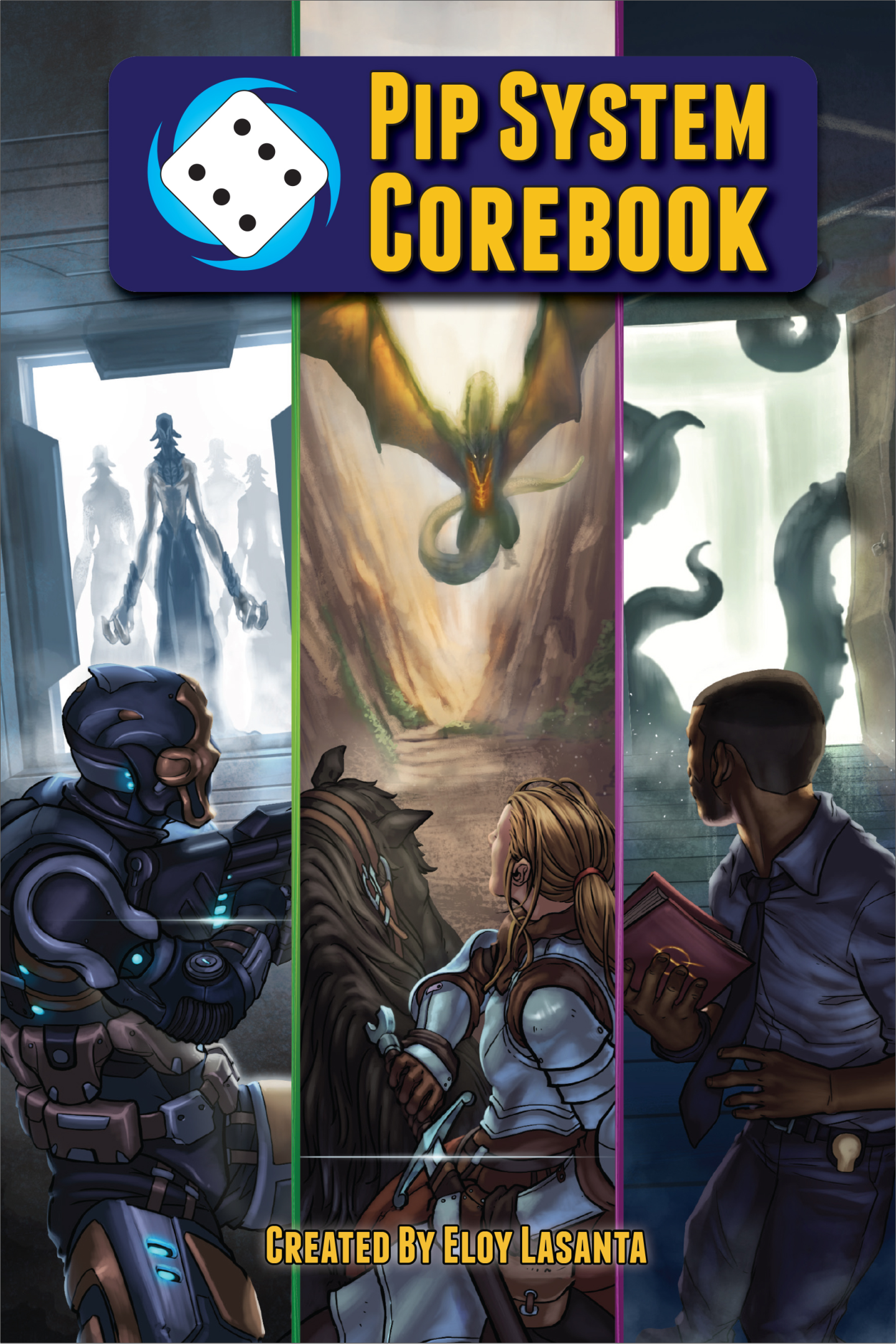Pip System Corebook
This article originally appeared in the November/December 2020 issue.
 Pip
System Corebook. Eloy Lasanta et alia.
Pip
System Corebook. Eloy Lasanta et alia.
Third Eye Games https://thirdeyegames.net
145pp, Softcover or PDF, available as both bundled
US$17.49(S,S+P)14.99(P)/UKú13.37(S,S+P)11.46(P)
The Pip System is designed to be simple enough to use to introduce children to role-playing games, but with the ability to “scale up” for adults. In this, it succeeds well; the basic rules are easy to understand and you can get started quickly. Pip System games will tend to focus on role-playing, not mechanics, and there isn’t a lot of “crunchy” detail to worry about – much that would be detailed differences in many other systems is left as cosmetic information that doesn’t actually affect play.
The fundamental mechanic of the Pip System is, for all intents and purposes, an “opposed d2” task system (even though d6 are used): The Game Guide (Pip’s term for the Referee) defines the relevant skills and qualities that the player-character would need to succeed at the task, and a “challenge rating” for such opposing factors as armor, environment, opponents, and so on. The player then rolls a number of “white” dice for the skills and qualities, and a number of “black” dice for the challenge rating. A roll of 4+ on a die is a “success”; the player-character succeeds at the task if the number of “white” successes is equal to or greater than the number of “black” successes.
Characters are created and advanced using a point-buy system; you start with an Archetype (which defines your Hits and basic skills) and purchase Skills and Qualities using Build Points. You can later advance your character by spending Progress Points, awarded by the Game Guide after each session.
The standard game rules specify a grand total of fourteen Skills, each with three Qualities, but these are generic enough to handle most situations in most game genres. (A Quality is like a specialization of a Skill. If a Skill is useful for a task, it gives the player “white” dice to the skill level; if a particular Quality is useful, it can add “white” dice to a maximum of the Quality level.) There is a section of the book that discusses creating your own Archetypes, Skills, and Qualities; while a particular genre/setting might suggest different Archetypes from those listed in this volume, it’s unlikely that you’ll really need to add or change Skills or Qualities.
As with the character, so too with the ‘gear’ – gear is Stuff That Makes A Difference, and it, too, has Qualities that can affect the number and color of dice you – or an opponent – roll. You don’t worry about the differences between pistols and rifles, or between calibers in a weapon; it’s simply a Ranged Weapon with qualities such as Powerful or Accurate (to go with Skills like “Aim” and Qualities like “Sharpshooter”).
The result is a game that can move quickly, without the need for repeatedly consulting tables – the Game Guide assigns ratings to the various components of a task, you roll, you count successes. If the roll indicates a marginal success, or an epic success or failure, it’s up to the Game Guide to narrate the results on the fly, to fit the situation.
No, it doesn’t seem like you should need 145 pages for that, does it? Well, you get plenty of examples, elaboration, explanation, and additional rules, plus general explanation of what roleplaying is, what the Game Guide does, how you can introduce children to roleplaying and the Pip system (and some behaviors to watch out for), and even some rules to simplify the system even more. It’s all relatively light reading, as RPGs go, and it really won’t take that long to get enough of a handle on the system to start playing. While saying that one could easily do a Traveller “conversion” wouldn’t be quite accurate, it probably wouldn’t be difficult to come up with a Traveller-esque setting and develop appropriate Archetypes.
Perhaps the Pip System isn’t a replacement for a Traveller ruleset, and there really isn’t much that could be grafted on, but there is certainly some potential for using it for quick ‘pick-up’ games, or perhaps low-prep fill-ins at a convention.
 Freelance
Traveller
Freelance
Traveller